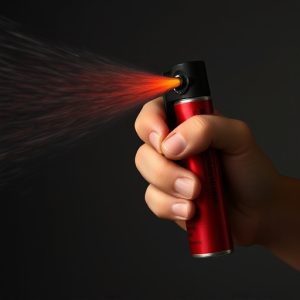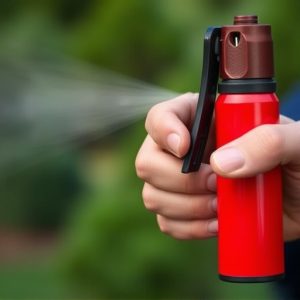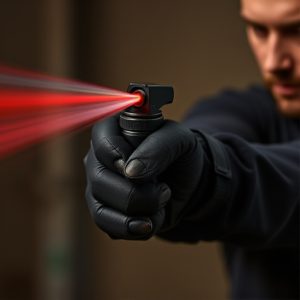Hot Climate Pepper Spray: Storage & Deployment Strategies for Law Enforcement
In hot climates, pepper spray effectiveness is significantly reduced by elevated temperatures and di…….
In hot climates, pepper spray effectiveness is significantly reduced by elevated temperatures and direct sunlight, leading to faster evaporation and decreased range/potency. To counteract this, law enforcement agencies need specialized hot climate pepper spray storage that maintains cool, dry conditions using air conditioning or refrigeration. Proper ventilation, secure containers, and strategic use during operations are essential for preserving potency, ensuring safety, and adhering to best practices in hot environment handling.
“In hot climate environments, law enforcement pepper spray weapons face unique challenges. This article delves into the specific considerations for these specialized tools, focusing on safe storage and effective deployment strategies. From understanding the unique properties of hot climate pepper spray to implementing best practices for handling high-temperature scenarios, this guide equips officers with crucial knowledge. Key factors include suitable storage solutions, proper maintenance, and tactical adjustments, ensuring optimal performance during operations in challenging conditions, particularly regarding Hot Climate Pepper Spray Storage.”
- Understanding Pepper Spray Weapons and Their Unique Challenges in Hot Climates
- Key Factors to Consider for Safe Storage of Law Enforcement Pepper Spray
- Best Practices for Deploying Pepper Spray in High-Temperature Environments
Understanding Pepper Spray Weapons and Their Unique Challenges in Hot Climates
Pepper spray weapons are a critical tool for law enforcement, designed to incapacitate and control individuals without causing permanent harm. However, their effectiveness and safe handling are significantly impacted by environmental factors, especially in hot climates. The primary challenge lies in the spray’s volatile nature; extreme heat can cause it to evaporate too quickly, reducing its range and potency, and potentially leading to off-target effects. This is particularly concerning for outdoor operations where officers may face direct sunlight and elevated temperatures.
Proper storage becomes paramount when dealing with hot climate pepper spray. It requires cool, dry conditions to maintain its integrity. Law enforcement agencies must invest in specialized storage facilities or containers that can regulate temperature and humidity levels, ensuring the spray remains effective. This is a unique challenge that demands specific considerations, including regular maintenance and monitoring, to guarantee optimal performance during critical operations in hot environments.
Key Factors to Consider for Safe Storage of Law Enforcement Pepper Spray
When storing law enforcement pepper spray, especially in hot climate regions, several key factors come into play to ensure safety and effectiveness. One of the primary considerations is temperature control. Pepper spray is sensitive to heat, and extreme temperatures can degrade its potency and even render it unusable. Storing it in a cool, dry place is essential to maintain its integrity. Air conditioning or refrigerated storage units are ideal for hot climate locations.
Additionally, proper ventilation is crucial to prevent the buildup of moisture. High humidity levels can cause pepper spray cans to corrode or fail, leading to potential safety hazards. Well-ventilated areas or desiccant packets can help absorb excess moisture. Secure storage containers that are lockable and resistant to tampering are also vital to safeguard the pepper spray from unauthorized access, especially in high-risk environments.
Best Practices for Deploying Pepper Spray in High-Temperature Environments
In hot climate conditions, proper storage and handling of pepper spray become even more critical. Extreme temperatures can impact the potency and effectiveness of the spray, so law enforcement agencies must adhere to specific best practices when deployed in such environments. One key consideration is secure storage; pepper spray should be kept in cool, dry places to maintain its stability. This often involves using specialized containers designed for temperature control or storing them in areas shielded from direct sunlight.
During operations, officers should use pepper spray strategically. In high-temperature settings, the spray’s canisters may expand, affecting their discharge. Officers must remain cautious and aware of this potential issue, ensuring accurate deployment while also considering the impact on their own safety and that of bystanders. Proper training is essential to familiarize officers with these considerations, enabling them to make informed decisions when facing challenging conditions.
In conclusion, law enforcement pepper spray remains a critical tool in hot climate scenarios, but its effective utilization hinges on understanding and addressing specific challenges. Optimal storage practices, as outlined in this article, are essential to ensure the weapon’s integrity, especially in regions with elevated temperatures. By following best deployment strategies in high-temperature environments, officers can maximize the safety and efficacy of pepper spray, thereby enhancing their capabilities during operations in challenging conditions.


